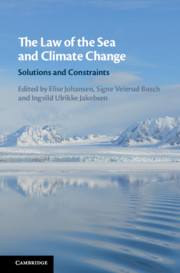Book contents
- The Law of the Sea and Climate Change
- The Law of the Sea and Climate Change
- Copyright page
- Contents
- Contributors
- Preface
- Acknowledgements
- International Instruments
- Table of Cases
- Abbreviations
- 1 The Role of the Oceans in Regulating the Earth’s Climate
- 2 Climate Change and the Anthropocene
- 3 Mitigation and Adaptation
- 4 Protecting the Marine Environment from Climate Change
- 5 Ocean Acidification
- 6 Regulating Greenhouse Gases from Ships
- 7 Carbon Capture and Storage and the Law of the Sea
- 8 Ocean Fertilization
- 9 Offshore Renewable Energy and the Law of the Sea
- 10 Marine Protected Areas and Climate Change
- 11 Integrating Climate Change in International Fisheries Law
- 12 Adaptation of Aquaculture to Climate Change
- 13 Law of the Sea Responses to Sea-Level Rise and Threatened Maritime Entitlements
- 14 Integrating Climate Change in the Governance of Areas beyond National Jurisdiction
- 15 The Law of the Sea and Its Institutions
- 16 The Law of the Sea as Part of the Climate-Change Regime Complex
- Bibliography
- Index
12 - Adaptation of Aquaculture to Climate Change
The Relevance of Temporal International Framework from a Norwegian Perspective
Published online by Cambridge University Press: 21 January 2021
- The Law of the Sea and Climate Change
- The Law of the Sea and Climate Change
- Copyright page
- Contents
- Contributors
- Preface
- Acknowledgements
- International Instruments
- Table of Cases
- Abbreviations
- 1 The Role of the Oceans in Regulating the Earth’s Climate
- 2 Climate Change and the Anthropocene
- 3 Mitigation and Adaptation
- 4 Protecting the Marine Environment from Climate Change
- 5 Ocean Acidification
- 6 Regulating Greenhouse Gases from Ships
- 7 Carbon Capture and Storage and the Law of the Sea
- 8 Ocean Fertilization
- 9 Offshore Renewable Energy and the Law of the Sea
- 10 Marine Protected Areas and Climate Change
- 11 Integrating Climate Change in International Fisheries Law
- 12 Adaptation of Aquaculture to Climate Change
- 13 Law of the Sea Responses to Sea-Level Rise and Threatened Maritime Entitlements
- 14 Integrating Climate Change in the Governance of Areas beyond National Jurisdiction
- 15 The Law of the Sea and Its Institutions
- 16 The Law of the Sea as Part of the Climate-Change Regime Complex
- Bibliography
- Index
Summary
In a book on the law of the sea and climate change, the relevance of the law of the sea for aquaculture may seem questionable: is the law of the sea, in fact, applicable to aquaculture? On the one hand, to a certain degree aquaculture takes place on land territory and/or in fresh waters, and is thereby classified as a land industry. In that case, the relevance of the law of the sea seems quite distant. On the other hand, in Norway and elsewhere, much aquaculture is conducted along the coast – and such installations are subject to coastal state sovereignty in internal waters and the territorial sea (12 nautical miles), according to the 1982 UN Convention on the Law of the Sea (LOSC) Article 2(1). Thus, legislation concerning aquaculture is mainly national law, and is not based on the law of the sea.
- Type
- Chapter
- Information
- The Law of the Sea and Climate ChangeSolutions and Constraints, pp. 289 - 308Publisher: Cambridge University PressPrint publication year: 2020



